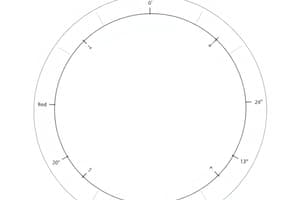Podcast
Questions and Answers
What is a definition of congruent segments?
What is a definition of congruent segments?
- They are segments.
- They are bisectors.
- Their measures are equal. (correct)
What defines a midpoint?
What defines a midpoint?
- It divides a segment into two congruent segments. (correct)
- It can be a point, line, or ray.
- It is the endpoint of a segment.
What is a segment bisector?
What is a segment bisector?
- A point that splits a segment into two sections. (correct)
- A line that can be perpendicular.
- Any ray that intersects a segment.
What is the measure of an acute angle?
What is the measure of an acute angle?
What defines a right angle?
What defines a right angle?
What is the measure of an obtuse angle?
What is the measure of an obtuse angle?
What defines a straight angle?
What defines a straight angle?
What defines congruent angles?
What defines congruent angles?
What is the definition of an angle bisector?
What is the definition of an angle bisector?
What defines an angle trisector?
What defines an angle trisector?
What are complementary angles?
What are complementary angles?
What are supplementary angles?
What are supplementary angles?
What is defined by a linear pair of angles?
What is defined by a linear pair of angles?
What defines equilateral polygons?
What defines equilateral polygons?
What defines equiangular polygons?
What defines equiangular polygons?
What characterizes perpendicular lines?
What characterizes perpendicular lines?
What does the Segment Addition Postulate state?
What does the Segment Addition Postulate state?
What does the Angle Addition Postulate state?
What does the Angle Addition Postulate state?
Flashcards are hidden until you start studying
Study Notes
Definitions of Congruent Segments and Angles
- Congruent segments have equal measures; if their lengths match, they are congruent.
- Congruent angles also share the same measure; identical angle sizes indicate congruence.
Midpoints and Segment Bisectors
- A midpoint divides a segment into two equal parts, each being a congruent segment.
- A segment bisector (point, line, or ray) also creates two congruent segments from the original segment.
Types of Angles
- Acute angles measure between 0 and 90 degrees.
- Right angles are exactly 90 degrees.
- Obtuse angles fall between 90 and 180 degrees.
- Straight angles are precisely 180 degrees.
Angle Relationships
- Angle bisectors divide an angle into two equal (congruent) angles.
- Angle trisectors split an angle into three congruent angles.
- Complementary angles have measures that sum to 90 degrees.
- Supplementary angles have measures that sum to 180 degrees.
Linear Pairs
- Two angles form a linear pair if they create a straight angle together, indicating their measures total 180 degrees.
Properties of Polygons
- Equilateral polygons have all sides of equal length.
- Equiangular polygons feature all angles being equal in measure.
Perpendicular Lines
- Lines are perpendicular if they intersect at right angles (90 degrees).
Postulates
- Segment Addition Postulate states that if point B is located between points A and C, then the sum of segments AB and BC equals segment AC.
- Angle Addition Postulate indicates that if point P lies within angle RST, then the measure of angle RSP plus the measure of angle PST equals the measure of angle RST.
Studying That Suits You
Use AI to generate personalized quizzes and flashcards to suit your learning preferences.




